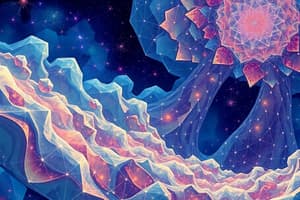Podcast
Questions and Answers
What natural phenomenon is described as following a Fibonacci pattern?
What natural phenomenon is described as following a Fibonacci pattern?
- The reproduction of fish
- The growth of coral reefs
- The branching of trees (correct)
- The migration of birds
How many grandparents does a honeybee drone have according to the Fibonacci pattern?
How many grandparents does a honeybee drone have according to the Fibonacci pattern?
- Four
- One
- Two (correct)
- Three
In what context is the speed of light particularly important?
In what context is the speed of light particularly important?
- GPS functionality (correct)
- Music streaming
- Internet speed
- Weather predictions
Which area utilizes math for the design and development of new products?
Which area utilizes math for the design and development of new products?
What is a common application of tessellations in technology?
What is a common application of tessellations in technology?
How does the Fibonacci sequence describe the ancestry of honeybees?
How does the Fibonacci sequence describe the ancestry of honeybees?
What technology relies on mathematics for public transportation?
What technology relies on mathematics for public transportation?
Which of the following technologies directly utilizes statistical mathematics?
Which of the following technologies directly utilizes statistical mathematics?
Which field relies heavily on statistics for advanced medical devices?
Which field relies heavily on statistics for advanced medical devices?
In which area could mathematical concepts be applied in media production?
In which area could mathematical concepts be applied in media production?
What aspect of business requires a good understanding of basic math for successful operations?
What aspect of business requires a good understanding of basic math for successful operations?
Which mathematical application is important for understanding public health trends?
Which mathematical application is important for understanding public health trends?
What is crucial when designing a roller coaster to ensure safety and performance?
What is crucial when designing a roller coaster to ensure safety and performance?
Which area of finance emphasizes understanding the principles of betting calculations?
Which area of finance emphasizes understanding the principles of betting calculations?
What concept is essential for creating effective music shuffling algorithms?
What concept is essential for creating effective music shuffling algorithms?
What is one of the primary uses of math in surveying?
What is one of the primary uses of math in surveying?
What defines symmetry in living organisms?
What defines symmetry in living organisms?
Which of the following is an example of a fractal pattern?
Which of the following is an example of a fractal pattern?
What is the nature of Fibonacci patterns in mathematical sequences?
What is the nature of Fibonacci patterns in mathematical sequences?
Where is a logarithmic spiral commonly observed in nature?
Where is a logarithmic spiral commonly observed in nature?
Which statement best describes patterns in nature?
Which statement best describes patterns in nature?
How does the splash from a water droplet demonstrate symmetry?
How does the splash from a water droplet demonstrate symmetry?
Which of the following demonstrates the concept of spirals in nature?
Which of the following demonstrates the concept of spirals in nature?
Which type of symmetry is found in a well-formed snowflake?
Which type of symmetry is found in a well-formed snowflake?
Flashcards are hidden until you start studying
Study Notes
Patterns in Nature
- Patterns are seen as anything non-random in the diversity of living things, exhibiting both order and irregularity.
- Symmetry involves reflectional or rotational balance, observed in living organisms and some non-living structures like snowflakes, which have six-fold symmetry.
- Fractals represent infinitely repeating patterns, apparent in various natural phenomena such as trees and rivers.
- Spirals are common in living things, found in sheep horns and nautilus shells; logarithmic spirals are observed in hurricanes and galaxies.
- The Fibonacci sequence (1, 1, 2, 3, 5, 8, ...) demonstrates growth patterns in plants and honeybee family trees, illustrating mathematical relationships in nature.
- Tessellations consist of repeated shapes, forming patterns in both organic and inorganic materials.
The Use of Mathematics
Technology
- Modern technology is heavily reliant on mathematics and statistics for functionalities like GPS, weather prediction, and internet operations.
- Key applications include navigation, speech recognition, public transportation, and digital music.
Engineering
- Mathematics is essential for designing and developing engineering components, modeling real-life scenarios, and maintaining structures.
- Key fields include construction, automotive design, robotics, and bridge building.
Media
- Mathematical concepts permeate media through camera design, movie set proportions, and numerical persuasion in advertising.
- Applications involve digital music, movie graphics, and polling/voting analysis.
Medicine and Health
- Advanced medical devices benefit from statistical research, ensuring that consumer electronics are profitable through quantitative analysis.
- Key areas include MRI technology, epidemiology, neurology, and population dynamics.
Finance and Business
- Effective business management requires strong mathematical skills for financial oversight and record-keeping.
- Important concepts encompass supply chain management, fraud detection, pricing strategies, and understanding loan structures.
Studying That Suits You
Use AI to generate personalized quizzes and flashcards to suit your learning preferences.




